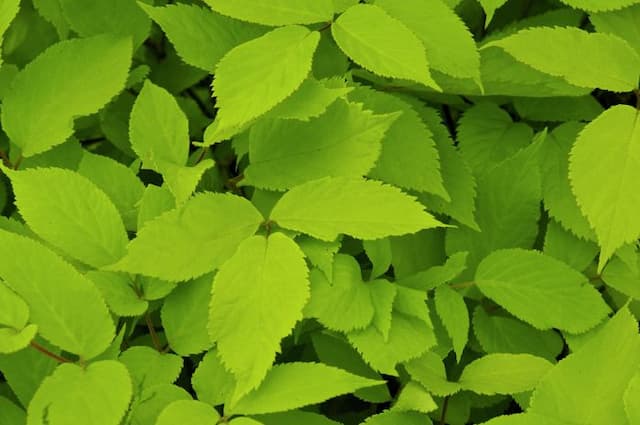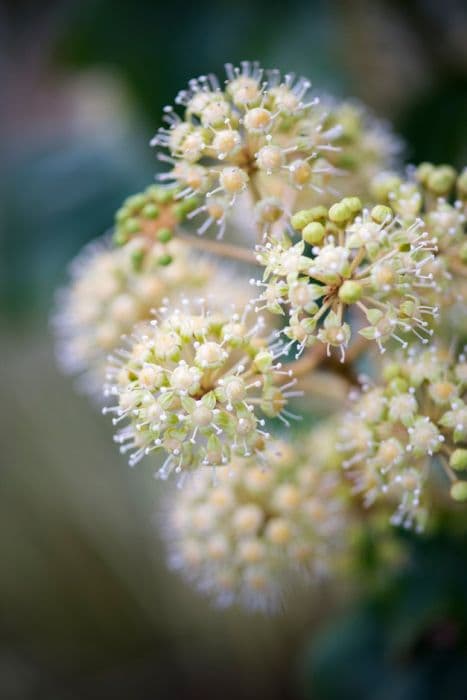English Ivy Hedera helix 'Shamrock'

ABOUT
The English Ivy 'Shamrock' is a distinctive variety of ivy known for its unique foliage. The plant features glossy, rich green leaves that are shaped like shamrocks, which is quite uncommon for an ivy. Each leaf normally has three lobes, which are angular and evenly spaced, giving it a very symmetrical appearance. The texture of the leaves is smooth with prominent veining that stands out against the leaf surface, enhancing their shape. As an evergreen climber, the English Ivy 'Shamrock' has long, flexible stems that cling to surfaces with small root-like structures. The leaves are arranged alternately along these stems, creating a dense mat of greenery. When grown as ground cover, the plant will form a lush carpet, with the leaves overlapping each other closely. In some conditions, the English Ivy 'Shamrock' may also produce small flowers and berries, although this is not its primary ornamental feature and may not occur as prominently as in other varieties. The flowers are typically inconspicuous, and the berries, if they appear, are small and may be hidden beneath the leaves. Overall, the English Ivy 'Shamrock' is appreciated for its decorative foliage with a symbolic shape that evokes the luck of the Irish. It brings a touch of whimsy and interest to gardens, walls, or as an indoor houseplant due to its distinctive leaf form.
About this plant
 Names
NamesFamily
Araliaceae.
Synonyms
English Ivy, Common Ivy, European Ivy.
Common names
Hedera helix 'Shamrock'.
 Toxicity
ToxicityTo humans
English ivy, commonly known as Hedera helix 'Shamrock', is toxic to humans if ingested. The main toxic components are triterpenoid saponins and polyacetylene compounds. Symptoms of English ivy poisoning can include abdominal pain, vomiting, and diarrhea. In some cases, excessive contact with the skin can lead to dermatitis. If large amounts of the plant are consumed, it can result in more severe symptoms such as difficulty in breathing, fever, polydipsia (excessive thirst), delirium, hallucinations, convulsions, and coma due to its toxin hederin.
To pets
English ivy is also toxic to pets, including cats and dogs. Ingesting any part of the plant can cause vomiting, abdominal pain, hypersalivation, and diarrhea. In some cases, English ivy ingestion can result in more severe symptoms such as ataxia (lack of muscle coordination), which could lead to injury from stumbling or falling. Pets may also experience dermatitis after skin contact with the plant. It's critical to keep English ivy out of reach of pets and consult a veterinarian promptly if you suspect your pet has ingested any.
 Characteristics
CharacteristicsLife cycle
Perennials
Foliage type
Evergreen
Color of leaves
Green
Height
6-8 feet (1.8-2.4 meters)
Spread
6-8 feet (1.8-2.4 meters)
Plant type
Climber
Hardiness zones
5-9
Native area
Europe
Benefits
 General Benefits
General Benefits- Visual Interest: The Hedera helix 'Shamrock', commonly known as English Ivy, adds aesthetic appeal with its attractive foliage and shape, enhancing garden design and indoor spaces.
- Versatility: English Ivy is highly versatile, able to grow in a variety of environments, whether indoors or outdoors, in pots or as ground cover.
- Low Maintenance: Requires minimal care once established, making it ideal for those with limited time for gardening.
- Adaptability to Light Conditions: It can adapt to different light conditions, from shade to partial sunlight, increasing its suitability for various locations.
- Soil Erosion Control: When used as ground cover outdoors, it helps prevent soil erosion by stabilizing the soil with its root system.
- Seasonal Interest: Offers year-round greenery as an evergreen plant, providing color and life to gardens even in colder months.
- Wildlife Support: English Ivy can provide shelter and food for birds and insects, contributing to local biodiversity.
 Medical Properties
Medical Properties- Expectorant: English Ivy has been used traditionally to help relieve coughs and remove mucus from the respiratory tract.
- Antispasmodic: It may help relieve smooth muscle spasms, particularly in the case of chronic bronchitis.
- Antimicrobial: English Ivy extracts have shown antimicrobial properties, which may help in combating certain pathogens.
- Anti-inflammatory: The plant has been used to reduce inflammation, which can be beneficial in the treatment of respiratory tract inflammation.
 Air-purifying Qualities
Air-purifying QualitiesThis plant is not specifically known for air purifying qualities.
 Other Uses
Other Uses- Traditional Dyes: Leaves and berries of English ivy can be used to make natural dyes for fabrics, yielding shades of yellow, green, and brown depending on the mordant used.
- Decorative Prints: The distinct leaves of English ivy can be used to create botanical prints on paper or fabric using a hammering technique to release their natural pigments.
- Insect Repellent Sachets: Dried English ivy leaves can be included in sachets with other herbs to repel moths and insects from closets and drawers.
- Craft & Sculpture: The flexible vines of English ivy can be woven into decorative shapes and figures, often used in basketry and other traditional crafts.
- Culinary Garnish: Though not edible, sprigs of English ivy can be used as decorative garnishes for special dishes at events, to be removed before consumption.
- Water Filtration: English ivy can be incorporated into living water filtration systems to absorb toxins, though care must be taken to avoid introducing it to natural waterways.
- Stress Relief Packs: The cooling sensation of English ivy leaves can be used in homemade stress relief packs when chilled and applied to the forehead.
- Photography Props: The vines and leaves of English ivy can be used as props in photography to add a green, lush element to the composition of images.
- Decoy Plants: English ivy can be used as a decoy plant in gardens to lure aphids and other pests away from more vulnerable crops or plants.
- Erosion Control: On hills or slopes, English ivy's dense growth can help prevent erosion by stabilizing the soil with its root system.
Interesting Facts
 Feng Shui
Feng ShuiEnglish Ivy is not used in Feng Shui practice.
 Zodiac Sign Compitability
Zodiac Sign CompitabilityEnglish Ivy is not used in astrology practice.
 Plant Symbolism
Plant Symbolism- Friendship and Affection: Hedera helix, commonly known as English Ivy, is often associated with friendship and affection, symbolizing the intertwined and dependent nature of close relationships.
- Fidelity: The plant's ability to cling and grow closely to structures or trees represents fidelity and loyalty in relationships.
- Eternal Life: Due to its evergreen nature, English Ivy is a symbol of eternal life, signifying the human desire for immortality and remembrance.
- Protection: In folklore, English Ivy is believed to offer protection against negative energy and evil spirits when grown around a home or garden.
- Survival and Resilience: The robustness of English Ivy, which allows it to thrive in challenging conditions, makes it a symbol of survival and resilience.
 Water
WaterEnglish Ivy 'Shamrock' generally prefers to be kept in evenly moist soil, so regular watering is important. It's best to water the plant thoroughly when the top inch of the soil feels dry to the touch; this could mean watering approximately once every week, but the frequency may vary depending on the environmental conditions like temperature and humidity. Each watering session should provide enough water to moisten the soil throughout the pot, which may equal around 16-32 ounces for a standard indoor pot size. Be cautious not to overwater as this can lead to root rot; proper drainage is vital.
 Light
LightEnglish Ivy 'Shamrock' thrives best in bright, indirect light. It can adapt to medium light conditions but will not fare well in direct, harsh sunlight, which can scorch its leaves. A north or east-facing window that receives gentle morning light or filtered light through a sheer curtain is ideal for English Ivy, providing the ambient light it needs to grow without the risk of damage from intense sun exposure.
 Temperature
TemperatureEnglish Ivy 'Shamrock' prefers temperatures between 50°F and 70°F for ideal growth, which generally falls within the typical indoor temperature range. The plant can survive temporary dips as low as 30°F but is not frost-hardy. Avoid exposing the plant to temperatures above 90°F, as excessive heat can stress the plant. Maintaining favorable temperature conditions within this range will promote the health and vitality of the English Ivy.
 Pruning
PruningPruning English Ivy 'Shamrock' is necessary to maintain its shape, encourage bushier growth, and remove any dead or damaged foliage. It's best to prune the plant in the early spring before new growth starts. You can prune it again in the summer if needed to control its size. Use clean, sharp scissors or pruning shears to make the cuts. This routine not only encourages a fuller appearance but also helps to keep the plant healthy by improving air circulation.
 Cleaning
CleaningAs needed
 Soil
SoilThe English Ivy 'Shamrock' thrives in well-draining potting soil with a bit of organic matter. A mix containing 1 part peat, 1 part pine bark, and 1 part coarse sand or perlite is ideal. Aim for a soil pH between 6.0 and 7.5 for optimal growth.
 Repotting
RepottingThe English Ivy 'Shamrock' should be repotted every two to three years to refresh the soil and prevent it from becoming root-bound. Spring is the best time to repot to allow the plant to recover during the growing season.
 Humidity & Misting
Humidity & MistingEnglish Ivy 'Shamrock' prefers a moderate humidity level of around 40 to 50 percent. If indoor air is too dry, mist the leaves regularly or use a humidifier to maintain the ideal humidity range.
 Suitable locations
Suitable locationsIndoor
Place English Ivy 'Shamrock' in bright, indirect light; keep soil moist but not soggy.
Outdoor
English Ivy 'Shamrock' can handle shade to partial sun; ensure rich, moist soil.
Hardiness zone
5-11 USDA
 Life cycle
Life cycleThe common name for Hedera helix 'Shamrock' is the English ivy or just ivy. The life cycle begins with germination, where the ivy seed must land in a moist, shaded environment to sprout roots and a stem. As a juvenile, the plant will exhibit aggressive growth with vine-like behavior, producing heart-shaped, lush green leaves and clinging to surfaces using aerial rootlets. During its climbing or spreading phase, the ivy will cover large areas if left unchecked and can live many years in this vegetative state. Upon reaching maturity, which can take several years, it will develop adult features such as oval leaves, woody stems, and it becomes capable of flowering—producing small, greenish-white flowers that are pollinated by insects. Following pollination, it produces berry fruits that contain seeds, which when dispersed, start new plants and continue the cycle.
 Propogation
PropogationPropogation time
Spring-Early Summer
The English Ivy 'Shamrock' can be effectively propagated through stem cuttings. The best time to propagate this plant is during late spring or early summer when the plant is actively growing. For stem cuttings, select a healthy stem and cut a segment around 4 to 6 inches long. Make the cut just below a leaf node, as this is where new roots will sprout from. Strip off the leaves from the bottom half of the cutting to expose the nodes, which increases the area available for root development. Then, dip the cut end in rooting hormone powder to enhance root growth. Finally, plant the cutting in a pot filled with moist potting soil, making sure at least one node is buried where roots can develop. Keep the soil consistently moist and in a warm location with indirect light until the cutting establishes a strong root system, which usually takes a few weeks.









